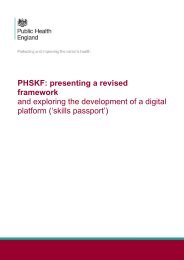Understanding patient flow in hospitals
understanding_patient_flow_in_hospitals_web_0
understanding_patient_flow_in_hospitals_web_0
Create successful ePaper yourself
Turn your PDF publications into a flip-book with our unique Google optimized e-Paper software.
34 <strong>Understand<strong>in</strong>g</strong> <strong>patient</strong> <strong>flow</strong> <strong>in</strong> <strong>hospitals</strong><br />
Achiev<strong>in</strong>g earlier discharge<br />
The other direct way to free up bed space is to f<strong>in</strong>d ways to move <strong>patient</strong>s out of<br />
hospital more quickly. This means very different th<strong>in</strong>gs depend<strong>in</strong>g on the <strong>patient</strong><br />
pathway concerned. For 90% of <strong>patient</strong>s stay<strong>in</strong>g under 7 days, the average stay is only<br />
1.12 days, or 29 hours. A 10% reduction <strong>in</strong> length of stay means reliably deliver<strong>in</strong>g<br />
the <strong>patient</strong> treatment pathway <strong>in</strong> about 180 m<strong>in</strong>utes less than is currently the case. If<br />
delivery is dependent on systems that measure length of stay <strong>in</strong> days at midnight but it<br />
is necessary to wait until the next day to see what has happened, it seems unlikely that<br />
the environment is conducive to achiev<strong>in</strong>g this.<br />
In contrast, 10% of <strong>patient</strong>s stay over 7 days, have an average stay of 18.8 days,<br />
use 65% of the beds and generate 32% of hospital <strong>in</strong><strong>patient</strong> revenue. A significant<br />
number of these <strong>patient</strong>s are likely to need, and would benefit from, rehabilitation. It<br />
is probable that design<strong>in</strong>g at-scale systems to provide this outside hospital could enable<br />
earlier discharge <strong>in</strong> a way that frees up significant space. Even if only 3% of <strong>patient</strong>s<br />
were cared for <strong>in</strong> a different way, 20% of acute beds could be released.<br />
This would have a dramatic impact on <strong>flow</strong> and is likely to elim<strong>in</strong>ate the need for<br />
escalation beds, significant amounts of temporary staff<strong>in</strong>g and the constant pressure to<br />
manage beds and capacity rather than provide care for <strong>patient</strong>s. The bed space freed up<br />
could also be used, <strong>in</strong> some cases, to br<strong>in</strong>g elective work that has been subcontracted<br />
out back <strong>in</strong>to the hospital, provid<strong>in</strong>g a useful f<strong>in</strong>ancial contribution.



